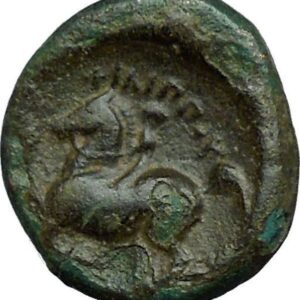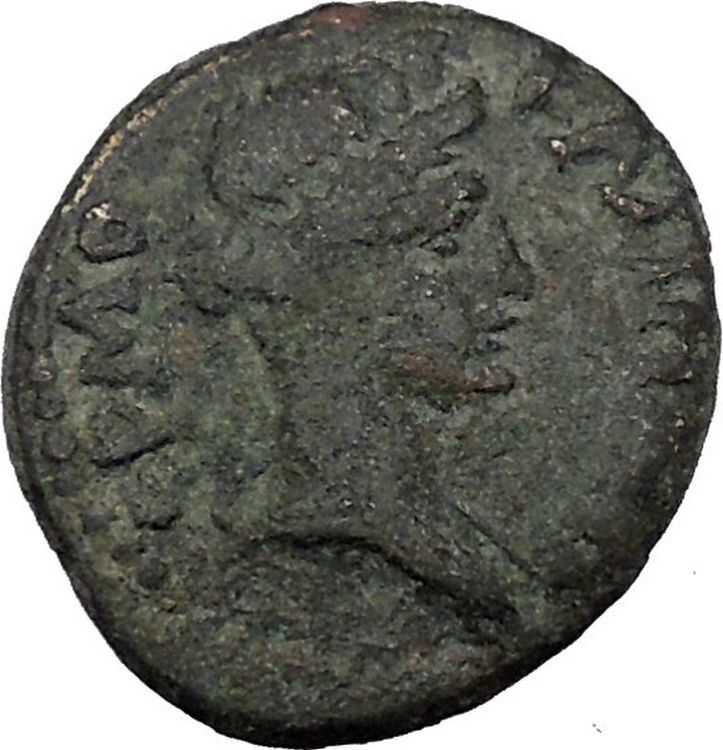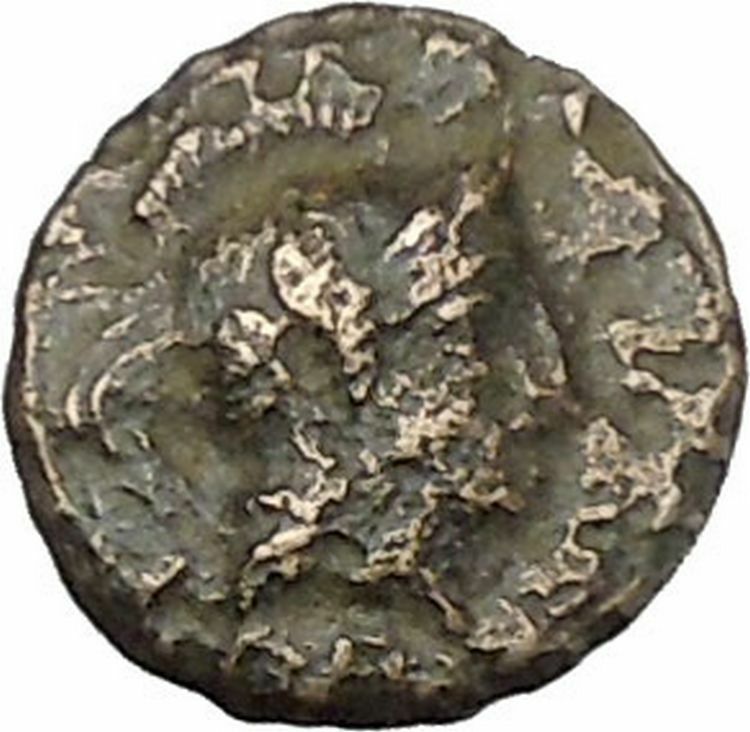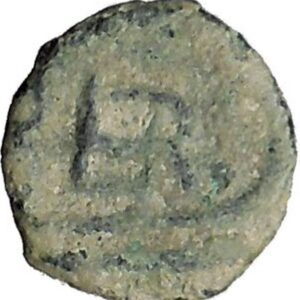|
Greek city of
Smyrna
in
Ionia
Bronze 13mm (3.43 grams) Struck circa 2nd-1st century B.C.
Reference: Sear 4567; B.M.C.14.242,56
Laureate head of Apollo right.
Hand in caestus, IMYPNAIΩN and palm to right,
MHTPOΔΩΡΟΣ to left.
An important city at the head of the gulf of Smyna, it was
refounded by Antigonos late in the 4th century B.C., nearly three centuries
after the destruction of the original settlement by Alyattes of Lydia. It rose
to be one of the great cultural centers of the East in Roman times. Smyrna
claimed to be the birthplace of Homer.
You are bidding on the exact item pictured,
provided with a Certificate of Authenticity and Lifetime Guarantee of
Authenticity.

Boxing scene from
Vergil
‘s
Aeneid
, Book 5, when the aging
Sicilian champion
Entellus
defeats the young Trojan
Dares, blood spurting from his injured head. Both wear caestūs.
Entellus sacrificed his prize, a bull, by landing a great blow to the
animal’s head. (Mosaic floor from a
Gallo-Roman
villa in
Villelaure
, France, ca. 175 AD) |
A cestus or caestus is an ancient battle
glove
, sometimes used in
pankration
. They were worn as are today’s
boxing gloves
, but were made with leather
strips and sometimes filled with iron plates or fitted with blades or spikes,
and used as weapons
.
Terminology
The word caestus is
Latin
, an
agent noun
derived from verb caedere,
meaning “to strike”, and as such can be reasonably translated as “striker”. The
Latin plural is caestūs (not caesti, since this is a
fourth declension
noun), although in English
“cestuses” has also been used.
Early Greek caestus
The first caestūs in
Ancient Greece
were series of leather thongs
tied over the hand for use in
boxing
-like competitions. The Greeks also
invented a variation called the sphaerae which were fitted with cutting
blades.
Roman caestus
Drawing of a caestus
Cestus on the
Boxer of Quirinal
|
Roman
variants included the myrmex (or
“limb-piercer”) and others featuring various iron plates, spikes, or studs.
Caestūs were frequently used in Roman
gladiatorial
bouts, where otherwise unarmed
combatants – mostly
slaves
– fought to the death. Caestūs
boxing
became increasingly bloody until
hand-to-hand fighting was officially banned in 393 AD.[citation
needed]
Boxer of Quirinal
The most famous depiction of the caestus is the
Hellenistic
sculpture
The Boxer of Quirinal
. The sitting figure is
wearing caestūs on his hands. It is part of the permanent collection of the
National Museum of Rome
.
See also
-
Brass knuckles
- Tekko
-
Weighted-knuckle glove

In
Greek
and
Roman mythology
,
Apollo,
is one of the most important and diverse of the
Olympian deities
. The ideal of the
kouros
(a beardless youth), Apollo has been
variously recognized as a god of light and the sun; truth and prophecy;
archery
; medicine and healing; music, poetry,
and the arts; and more. Apollo is the son of
Zeus and Leto
, and has a
twin
sister, the chaste huntress
Artemis
. Apollo is known in Greek-influenced
Etruscan mythology
as Apulu. Apollo was
worshiped in both
ancient Greek
and
Roman religion
, as well as in the modern
Greco
–Roman
Neopaganism
.
As the patron of Delphi
(Pythian Apollo), Apollo was an
oracular
god — the prophetic deity of the
Delphic Oracle
. Medicine and healing were
associated with Apollo, whether through the god himself or mediated through his
son Asclepius
, yet Apollo was also seen as a god
who could bring ill-health and deadly
plague
as well as one who had the ability to
cure. Amongst the god’s custodial charges, Apollo became associated with
dominion over
colonists
, and as the patron defender of herds
and flocks. As the leader of the
Muses (Apollon Musagetes) and director of their choir, Apollo
functioned as the patron god of music and
poetry
.
Hermes
created the
lyre for him, and the instrument became a common
attribute
of Apollo. Hymns sung to Apollo were
called paeans
.
In Hellenistic times, especially during the third century BCE, as Apollo
Helios he became identified among Greeks with
Helios
,
god of the sun
, and his sister Artemis
similarly equated with
Selene
,
goddess of the moon
. In Latin texts, on the
other hand, Joseph Fontenrose declared himself unable to find any conflation of
Apollo with
Sol
among the
Augustan poets
of the first century, not even
in the conjurations of
Aeneas
and
Latinus
in
Aeneid
XII (161–215). Apollo and Helios/Sol
remained separate beings in literary and mythological texts until the third
century CE.
Smyrna (Ancient
Greek: Σμύρνη or Σμύρνα) was an
ancient city located at a central and strategic point on the
Aegean
coast of Anatolia
; aided by its advantageous port conditions, its ease of defence and
its good inland connections, Smyrna rose to prominence. The ancient city is
located at two sites within modern
Izmir
, Turkey
.
While the first site, likely to have started as a native foundation, rose to
prominence during the
Archaic Period
as
one of the principal ancient Greek settlements in western
Anatolia
,
the second, whose foundation is associated with
Alexander
the Great
, reached metropolitan proportions especially during the period of
the Roman Empire
, from which time and particularly from after a 2nd century AD
earthquake, most of the present-day remains date.
In practical terms, a distinction is often made between Old Smyrna,
the initial settlement founded around the 11th century BC, first as an
Aeolian
settlement, and later taken over and developed during the
Archaic Period
by
the Ionians
,
and Smyrna proper, the new city moved into from the older one as of the
4th century BC and whose foundation was inspired, and perhaps also initiated, by
Alexander
the Great
. Old Smyrna was located on a small peninsula connected to the
mainland by a narrow isthmus at the northeastern corner of the inner
Gulf of İzmir
, at
the edge of a fertile plain and at the foot of
Mount Yamanlar
which had seen the earlier Anatolian settlement commanding
the gulf. New Smyrna developed simultaneously on the slopes of the Mount
Pagos
(Kadifekale
today) and alongside the coastal strait immediately below where a small bay
existed until the 18th century. The core of the late
Hellenistic
and early
Roman
Smyrna forms today the large area of İzmir Agora Open Air Museum at this
site. Research is being pursued at the sites of both the old and the new cities
in a continuous manner and in a regionalized structure, since 1997 for Old
Smyrna and since 2002 for the Classical Period city, in collaboration between
İzmir Archaeology Museum
//
Etymology
For full explanations on etymology of the city’s name, see
İzmir
There are several explanations brought forth as regards its name. One of
these involve a Greek myth derived from an
eponymous
Amazon
named
Smyrna, which was also the name of a
quarter
of Ephesus
, and can also be recognized under the form
Myrina
, a
city of Aeolis
.
Smyrna is an ancient
Greek
word for
myrrh
.
Third
millennium to 687 BC
The region was settled at least as of the beginning of the third millennium
BC
, or perhaps earlier as the recent finds in
Yeşilova Höyük
suggests. It could have been a city of the autochthonous
Leleges
before the
Greek
colonists started to settle along the coast of
Asia Minor
as of the beginning of the first millennium BC. Throughout
antiquity Smyrna was a leading city-state of
Ionia
, with
influence over the Aegean shores and islands. Smyrna was also among the cities
that claimed Homer
as a resident.
The early Aeolian
Greek settlers of
Lesbos
and
Cyme
,
expanding eastwards, occupied the valley of Smyrna. It was one of the
confederacy of Aeolian city-states, marking the Aeolian frontier with the Ionian
colonies.
Strangers or refugees from the Ionian city of
Colophon
settled in the city and finally (traditionally in 688 BC) by an uprising Smyrna
passed into their hands and became the thirteenth of the Ionian
city-states
.
Revised mythologies made it a colony of Ephesus
In 688 BC the Ionian boxer Onomastus of Smyrna won the prize at Olympia, but the
coup was probably then a recent event. The Colophonian conquest is
mentioned by Mimnermus (before 600 BC), who counts himself equally of Colophon
and of Smyrna. The Aeolic form of the name was retained even in the
Attic
dialect
, and the
epithet
“Aeolian Smyrna” remained current long after the conquest.
Smyrna’s position at the mouth of the small river
Hermus
at the
head of a deep arm of the sea (Smyrnaeus Sinus) that reached far inland
and admitted Greek trading ships into the heart of
Lydia
, placed it
on an essential trade route between Anatolia and the Aegean and raised Smyrna
during the seventh century BC to power and splendor. One of the great trade
routes which cross Anatolia descends the Hermus valley past
Sardis
, and
then, diverging from the valley, passes south of
Mount
Sipylus
and crosses a low pass into the little valley where Smyrna lies
between the mountains and the sea.
Miletus
and
later Ephesus were situated at the sea end of the other great trade route across
Anatolia and competed for a time successfully with Smyrna; but after both
cities’ harbors silted up, Smyrna remained without a rival.
The Meles River, which
flowed by Smyrna, is famous in literature and was worshiped in the valley. A
common and consistent tradition connects
Homer
with the
valley of Smyrna and the banks of the Meles; his figure was one of the stock
types on coins of Smyrna, one class of which
numismatists
call “Homerian”; the epithet Melesigenes was applied to
him; the cave where he was wont to compose his poems was shown near the source
of the river; his temple, the Homereum, stood on its banks. The steady
equable flow of the Meles, alike in summer and winter, and its short course,
beginning and ending near the city, are celebrated by
Aristides
and Himerius. The description applies admirably to the stream which rises from
abundant springs east of the city and flows into the southeast extremity of the
gulf.
The archaic city (“Old Smyrna”) contained a temple of
Athena
from the
seventh century BC.
Lydian
period

Map of Smyrna and Other Cities within the Lydian Empire
When the Mermnad kings raised the Lydian power and aggressiveness, Smyrna was
one of the first points of attack.
Gyges (ca. 687—652
BC) was, however, defeated on the banks of the Hermus, the situation of the
battlefield showing that the power of Smyrna extended far to the east. A strong
fortress was built probably by the Smyrnaean Ionians to command the valley of
Nymphi, the ruins
of which are still imposing, on a hill in the pass between Smyrna and Nymphi.
According to Theognis (circa 500 BC), it was pride that destroyed Smyrna.
Mimnermus laments the degeneracy of the citizens of his day, who could no longer
stem the Lydian advance. Finally,
Alyattes
II
(609—560 BC) conquered the city and sacked it, and though Smyrna did not
cease to exist, the Greek life and political unity were destroyed, and the
polis
was
reorganized on the village system. Smyrna is mentioned in a fragment of Pindar
and in an inscription of 388 BC, but its greatness was past.
Hellenistic
period
Alexander the Great
conceived the idea of restoring the Greek city in a
scheme that was, according to
Strabo
,
actually carried out under Antigonus (316—301 BC) and Lysimachus (301 BC—281
BC), who enlarged and fortified the city. The ruined acropolis of the ancient
city, the “crown of Smyrna,” had been on a steep peak about 1250 feet high,
which overhangs the northeast extremity of the gulf. Modern Izmir was
constructed atop the later
Hellenistic
city, partly on the slopes of a rounded hill the Greeks called
Pagos
near the southeast end of the gulf, and partly on the low ground between the
hill and the sea. The beauty of the Hellenistic city, clustering on the low
ground and rising tier over tier on the hillside, was frequently praised by the
ancients and is celebrated on its coins.
Smyrna is shut in on the west by a hill now called Deirmen Tepe, with the
ruins of a temple on the summit. The walls of Lysimachus crossed the summit of
this hill, and the acropolis occupied the top of Pagus. Between the two the road
from Ephesus entered the city by the Ephesian gate, near which was a gymnasium.
Closer to the acropolis the outline of the stadium is still visible, and the
theatre was situated on the north slopes of Pagus. Smyrna possessed two harbours.
The outer harbour was simply the open roadstead of the gulf, and the inner was a
small basin with a narrow entrance partially filled up by
Tamerlane
in 1402
AD
.
The streets were broad, well paved and laid out at right angles; many were
named after temples: the main street, called the Golden, ran across the city
from west to east, beginning probably from the temple of Zeus Akraios on the
west slope of Pagus, and running round the lower slopes of Pagus (like a
necklace on the statue, to use the favorite terms of Aristides the orator)
towards Tepecik outside the city on the east, where probably stood the temple of
Cybele
,
worshipped under the name of Meter Sipylene, the patroness of the city. (name
deriving from the nearby Mount Sipylus, which bounds the valley of the city’s
backlands). The plain towards the sea was too low to be properly drained, and
hence in rainy weather the streets of the lower town were deep with mud and
water.
At the end of the Hellenistic period, in 197 BC, the city suddenly cut its
ties with King
Eumenes of Pergamum
and instead appealed to Rome for help. Because Rome and
Smyrna had had no ties until then, Smyrna created a cult of Rome to establish a
bond, and the cult eventually became widespread through the whole Roman Empire.
As of 195 BC, the city of Rome started to be deified, in the cult to the goddess
Roma
.
In this sense, the Smyrneans can be considered as the creators of the goddess
Roma.
In 133 BC, when the last Attalid king Eumenes III died without an heir, his
will conferred his entire kingdom, including Smyrna, to the Romans. They
organized it into the Roman
province of Asia
, making
Pergamum
the capital. Smyrna, however, as a major seaport, became a leading
city in the newly constituted province.
Roman
and Byzantine period
As one of the principal cities of Roman Asia,
Smyrna vied with Ephesus and Pergamum for the title “First City of Asia.”
A Christian church existed here from a very early time, probably originating
in the considerable Jewish colony. It was one of the
seven churches
addressed in the
Book of
Revelation
.
Saint
Ignatius of Antioch
visited Smyrna and later wrote letters to its bishop,
Polycarp
. A
mob of Jews and pagans abetted the martyrdom of Polycarp in AD 153.[6]
Saint Irenaeus
,
who heard Polycarp as a boy, was probably a native of Smyrna.
Another famous resident of the same period was
Aelius Aristides
.
Polycrates reports a succession of bishops including Polycarp of Smryna, as
well as others in nearby cities such as
Melito
of Sardis. Related to that time the German historian W. Bauer wrote:
Asian Jewish Christianity received in turn the knowledge that henceforth
the “church” would be open without hesitation to the Jewish influence
mediated by Christians, coming not only from the apocalyptic traditions, but
also from the synagogue with its practices concerning worship, which led to
the appropriation of the Jewish passover observance. Even the observance of
the sabbath by Christians appears to have found some favor in Asia…we find
that in postapolstolic times, in the period of the formation of
ecclesiastical structure, the Jewish Christians in these regions come into
prominence.
In the late second century,
Irenaeus
also noted:
Polycarp also was not only instructed by apostles, and conversed with
many who had seen Christ, but was also, by apostles in Asia, appointed
bishop of the Church in Smyrna…always taught the things which he had learned
from the apostles, and which the Church has handed down, and which alone are
true. To these things all the Asiatic Churches testify, as do also those men
who have succeeded Polycarp.
Tertullian
wrote circa 208 A.D.
Anyhow the heresies are at best novelties, and have no continuity with
the teaching of Christ. Perhaps some heretics may claim Apostolic antiquity:
we reply: Let them publish the origins of their churches and unroll the
catalogue of their bishops till now from the Apostles or from some bishop
appointed by the Apostles, as the Smyrnaeans count from Polycarp and John,
and the Romans from Clement and Peter; let heretics invent something to
match this.
Hence, apparently the church in Smyrna was one of only two that Tertullian
felt could have had some type of apostolic succession. During the mid-third
century, however, changes occurred in Asia Minor, and most there became
affiliated with the Greco-Roman churches.
When
Constantinople
became the seat of government, the trade between Anatolia and
the West diminished in importance, and Smyrna declined. The Seljuk commander
Çaka Bey
seized Smyrna in 1084 and used it as a base for naval raids, but
the city was recovered by the generals of
Alexios I
Komnenos
. The city was several times ravaged by the
Turks
, and had
become quite ruinous when the emperor John Ducas Vatatzes about 1222 rebuilt it.
Ottoman
period
Main article:
Izmir
Ibn Batuta
found it still in great part a ruin when the homonymous chieftain
of the
Beylik
of
Aydın
had conquered it about 1330 and made his son Umur governor. It became
the port of the emirate. Soon afterwards the
Knights of Saint John
established themselves in the town but failed to
conquer the citadel. In 1402
Tamerlane
stormed the town and massacred almost all the inhabitants. The
Mongol
conquest was only temporary, but Smyrna was recovered by the Turks
under the Aydın dynasty after which it became
Ottoman
, when the
Ottomans took over the lands of Aydın.
Greek influence was so strong in the area that the Turks called it “Smyrna of
the infidels” (Gavur Izmir).
While Turkish sources track the emergence of the term to the 14th century when
two separate parts of the city were controlled by two different powers, the
upper İzmir being Muslim and the lower part of the city Christian.[citation
needed][clarification
needed]
The Ottomans continued to control the area, with the exception of the
1919-1922 period
, when the city was assigned to Greece by the
Treaty of Sevres
. The
Great
Fire of Smyrna
destroyed much of the city just after the conflict.
Agora
The remains of the agora
of Smyrna constitute today the space of İzmir Agora Museum in
İzmir’s Namazgah quarter, although its area is commonly referred to as
“Agora” by the city’s inhabitants.
Situated on the northern slopes of the Pagos hills, it was the commercial,
judicial and political nucleus of the ancient city, its center for artistic
activities and for teaching.
İzmir Agora Open Air Museum consists of five parts, including the
agora area, the base of the northern
basilica
gate, the stoa and the ancient shopping centre.
The agora of Smyrna was built during the Hellenistic era. After a destructive
earthquake in 178 AD, Smyrna was rebuilt in the Roman period (second century AD)
under the emperor
Marcus Aurelius
,
according to an urban plan drawn by
Hippodamos
. The bust of the emperor’s wife
Faustina
on the second arch of the western stoa confirms this fact. It was constructed on
a sloping terrain in three floors, close to the city center. The terrain is 165
m wide and 200 m long. It is bordered on all sides by
porticos
.
Because a
Byzantine
and later an
Ottoman
cemetery
were located over the ruins of the agora, it was preserved from modern
constructions. This agora is now the largest and the best preserved among
Ionian
agoras. The agora is now surrounded by modern buildings that still cover its
eastern and southern parts. The agora was used until the Byzantine period.
On entering the courtyard, too the left is the western
stoa, in the back
the basilica
and on the right side the Ottoman cemetery. The courtyard was surrounded by
porticoes on three sides. The basilica and the western portico were built over
an infrastructure of basements with round arches to protect them against future
earthquakes. The eastern end and the southern porticoes consisted of a two-floor
compounded structure. Beneath the basilica was a covered market place. The
design of the basement has a strong resemblance with the
crypto-porticus
constructions of the western provinces. The monumental
entrance at the eastern side was one of the most magnificent and arched
structures of the Hellenistic era.
A two-storied stoa, 17.5 m wide, was constructed at the eastern and western
side of the agora. Each stoa was divided in three galleries by two rows of
columns. Each stoa had an upper story. The stoas were protected from sun and
rain by a roof. These impressive structures measured 75 m by 18 m. The southern
part of the western stoa has many water channels and large water reservoirs,
pointing to the presence of water in the agora.
Excavations

Engraving with a view of the site of Smyrna Agora a few years after
the first explorations (1843)
Although Smyrna was explored by
Charles Texier
in the 19th century and the
German
consul
in İzmir had purchased the land around the ancient theater in 1917 to start
excavations, the first scientific digs can be said to have started in 1927. Most
of the discoveries were made by archaeological exploration carried as an
extension during the period between 1931-1942 by the
German
archaeologist
Rudolf Naumann
and
Selâhattin Kantar
, the director of İzmir and Ephesus museums. They uncovered
a three-floor,
rectangular
compound with stairs in the front, built on
columns
and
arches around a
large courtyard
in the middle of the building.
New excavations in the agora began in 1996 and are being continued regularly
since 2002 under the sponsorship of the Metropolitan Municipality of İzmir. A
primary school that was adjacent to agora and that fell victim to a fire in 1980
not having been reconstructed, its space could be incorporated into the
historical site. This meant that not only could the area of agora be increased
to 16,590 square metres but also new digs could be launched in a previously
unexplored zone. The archaeologists and the local authorities, means permitting,
are also keenly eyeing a neighbouring multi-storey car park, which is known to
cover an important part of the ancient settlement. During the present
renovations the old restorations in concrete are gradually being replaced by
marble.
The most important result of the new studies has been the discovery of the
agora’s northern gate. It has been concluded that embossed figures of the
goddess
Hestia
found in
these digs were a continuation of the
Zeus
altar
uncovered
during the first digs. Statues of the
gods
Hermes
,
Dionysos
,
Eros
and Heracles
have also been found, as well as many statues, heads, embossments,
figurines and monuments of people and animals, made of marble, stone, bone,
glass, metal and terracotta. Inscriptions found here list the people who
provided aid to Smyrna after the
earthquake
of 178 AD.
Toponyms
Several American cities have been named after Smyrna, including
Smyrna, Georgia
;
Smyrna,
Tennessee
;
Smyrna, Delaware
and
New Smyrna Beach, Florida
.
|






.jpg/165px-Cestus_(PSF).jpg)







